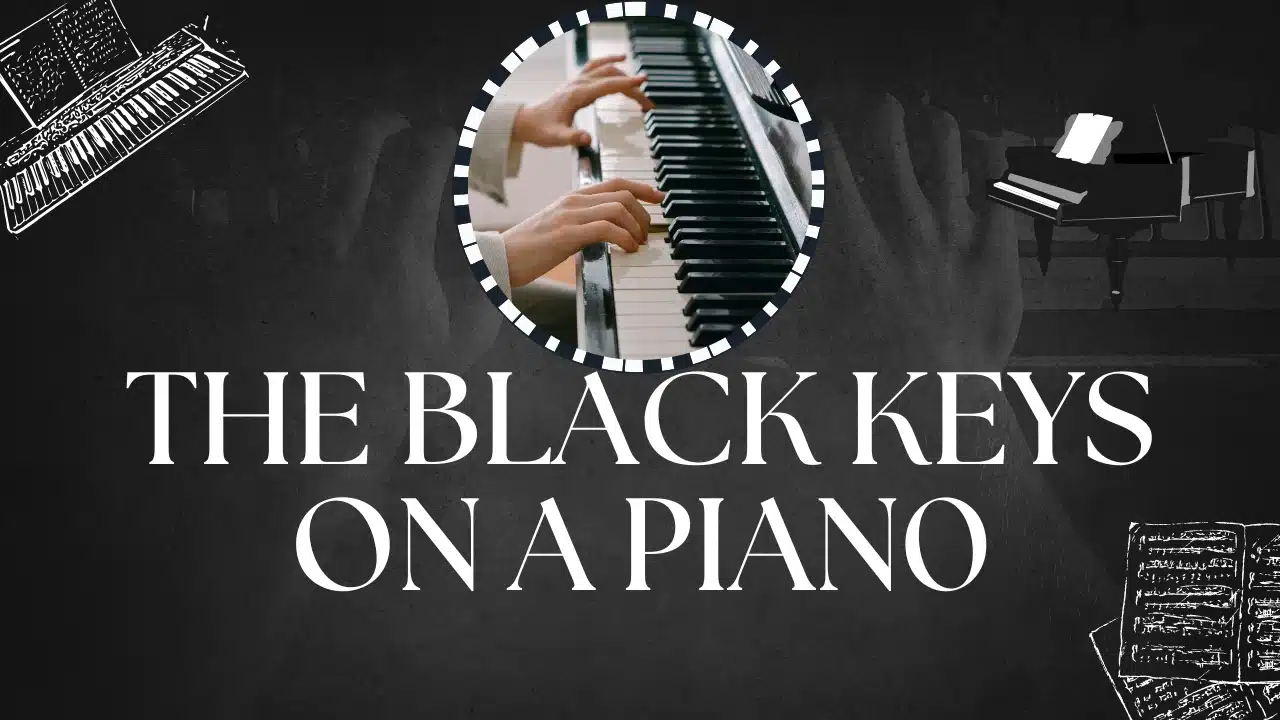- How Many Black Keys are on a Piano?
- The Pattern of Black and White Keys
- The Role of Black Keys
- Sharps and Flats
- Counting the Black Keys
- Groups of Black Keys
- The Math Behind 36 Black Keys
- Variations in Piano Keyboards
- The Importance of Black Keys in Music
- Learning to Use the Black Keys
- Simple Songs Using Black Keys
- Conclusion
One of the ways to focus on the black keys on a piano is to identify them as the odd ones out. The standard full-sized pianos have a total of 88 keys that are categorized as black and white. These keys are organized to repeat a certain sequence all through the keyboard.
How Many Black Keys are on a Piano?
Most of the time, the piano with an 88 key set has 36 black keys that can be played. However, some pianos might have or not have some black keys, so this number could vary a little, but the highest count is 36 for normal and short-size pianos.
The Pattern of Black and White Keys
The arrangement of black and white keys on a piano is a recurring series throughout the entire keyboard and is not undetermined. This is because it is divided into 12 keys that are important for the creation of Western music.
In the set of 12 keys, you shall find:
- 7 white keys
- 5 black keys
The white keys are the ones that come first, followed by the black keys on piano ones and so on for the entire length of the keyboard.
The Role of Black Keys
You may be curious about the fact that pianos have black keys at all. These keys are a fundamental part of music and with them only a few new things can be accomplished.
Sharps and Flats
The black keys piano notes are where the sharp and flat notes of music are written. In the theory of Western music, we have seven main notes (A, B, C, D, E, F, G) that the white keys represent. The black keys enable us to play the notes between the main notes, getting us a total of 12 notes per octave.
For example:
- The black key between F and G can be called the sharp F (F#) or G-flat (Gb)
- The black key between C and D can be called the sharp C (C#) or D-flat (Db)
Counting the Black Keys
To give you an insight into the composition of the black keys on a piano, let us take a simple look at the black key placement on an 88 key standard piano and see how the total of 36 is made.
Groups of Black Keys
Remember that the black keys on piano are set in the form of sectors of two and three. In a complete piano model, there will be:
- 7 groups of two black keys
- 7 groups of three black keys
The Math Behind 36 Black Keys
In order to figure out the total number of black keys take this step:
- (7 groups of two) × 2 = 14 keys
- (7 groups of three) × 3 = 21 keys
- 14 + 21 = 35 keys
You might see that we derived 5 keys, not 36. The extra black key that is needed comes from the highest combination of two black keys that are often not placed on all pianos, being incomplete, which are only one in number instead of two that are usually found.
Variations in Piano Keyboards
The standard 88-key pianos types are very common, but you can also find some other variations as well, for example:
Smaller Pianos
Some smaller pianos or digital keyboards might have less than 88 keys. They usually come in these sizes:
- 76-key pianos: Usually have 31 black keys
- 61-key pianos: Usually have 25 black keys
- 49-key pianos: Usually have 20 black keys
Extended Range Pianos
Some pianos have more than 88 keys. For instance:
- 97-key pianos: Usually have 40 black keys
- 108-key pianos: Usually have 45 black keys
The Importance of Black Keys in Music
The black keys play a huge role in the development of exciting and multi-genre music. With them, we can modulate keys, make the harmonies feature more than one note, and add depth to musical expression.
Playing in Different Keys
Black keys function on a piano are what enable us to play a song in various keys. Without them, we only have a chance to play in C major. However, the versatility that comes with the ability to play in different keys is so great that it fosters musical creativity and accommodates different ranges of singers when accompanying them.
Creating Complex Harmonies
Black keys function on piano are the constituents of additional harmonies and more sophisticated chord progressions. Even the abundant and haunting jazz chords require the use of many black keys on a piano notes.
Expressing Emotion
More often, by attaching black keys to a musical piece, the expression can be intensified. Through the more subtle dissonance the sharps or flats introduce, music turns into a vessel for conflict, resolution, or sadness, and the effect can change based on the framing.
Learning to Use the Black Keys
To the beginners, black keys function on piano might appear to be at once forbidding and impenetrable, but they are as essential to piano playing as are other keys, and learning to use them effectively will strongly add to your musical skills.
Starting with Scales
One of the best ways to get your hands acquainted with the black is to use scales where they are involved. To start with, the pentatonic scale is an ideal platform for experienced players as it involves as much as many black keys.
Simple Songs Using Black Keys
Many of the easy songs that can be played are built only on the black keys, for example, “Mary Had a Little Lamb” and “Twinkle, Twinkle Little Star” are the most popular melodies for little kids to practice on the black keys.
Conclusion
The 88-key standard piano has 36 black keys. These keys have a major function in music since they extend the note range, allow for the usage of chords which are more sophisticated, and give more possibilities for the expression of feelings through music. You will want to make sure to grasp and understand the relationship’s black keys have within the instruments that they belong to as well as piano and the accuracy of the music as it unveils itself to you as a beginner, no matter if it is the white and or black keys in the mix. Above all; all 88 keys – including those 36 black ones – have exclusive offerings!. To conclude knowing this keys will greatly benefit pianists. If you are a beginner wanted to start your piano journey but having no clue, talk with the best pianist to clear all your doubts and start your free online piano demo classes with musicmaster.































